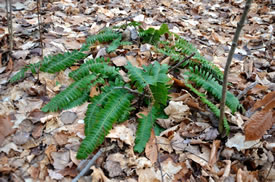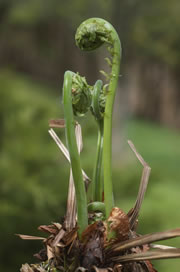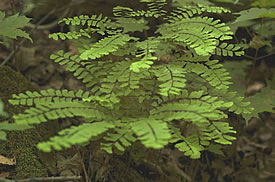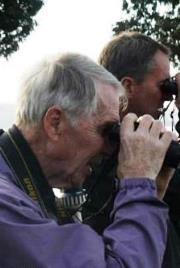Ferns and mosses of the Happy Valley Forest

The Christmas fern, green against dead leaves in the fall (Photo by Dr. Henry Barnett)
The Happy Valley Forest is home to a large number of common and uncommon ferns (my daughter Ann Love has records of 18 fern species in this forest area). The Christmas fern is very common in the forest and at its edges. It retains its green chlorophyll colouration through the winter including Christmastime, hence its name; it gives us green ferns in the snow.

Edible ostrich fern fiddleheads (Photo by Dr. Henry Barnett)
The ostrich fern occurs in several damp and wet spots and produces a crop of new growth of ferns, which have been dubbed fiddle heads displayed here. Our family always watch for their arrival in early spring as they are plentiful and make easy picking and good eating.

Maidenhair fern (Photo by Dr. Henry Barnett)
Maidenhair fern is an attractive species but is becoming uncommon, possibly being too eagerly sought as a domestic plant renowned for its particular beauty.
The rattlesnake fern is quite common. On the edges of the forest, the hay-scented fern is the least common but distinctive. The ground pine looks like, and commonly is mistaken for, a fern but is a clubmoss.
Ferns found in Happy Valley Forest area and known to Ann Love and myself are:
- hay-scented fern
- Goldie’s fern
- cliff brake fern
- crested fern
- wood fern
- bracken (fern)
- sensitive fern
- ostrich fern
- Christmas fern
- grape fern
- cinnamon fern
- interrupted fern
- New York fern
- oak fern
- rattlesnake fern
- marginal wood fern
- maidenhair fern
- bladder bulblet fern
This is the 13th in a series of blog posts Dr. Barnett will be contributing to Land Lines in the next few months.


